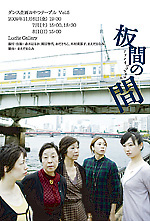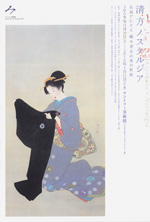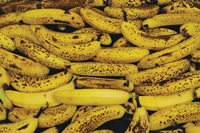 |
Picks is a monthly sampling of Japan's art scene, offering short reviews of exhibitions at museums and galleries in recent weeks, with an emphasis on contemporary art by young artists. |
 |
 |
 |
15 January 2010 |
 |
| 1 | 2 | |
 |
|
 |
 |
|
|
 |
 |
Treasures of the Imperial Collections - Splendor of Japanese Art
|
| 6 October - 29 November 2009 |
Tokyo National Museum Heiseikan
(Tokyo) |
 |
| A rare opportunity to see works from the Imperial Household and its storehouses, including the famed Shosoin, this exhibition was one of unremitting splendor. Highlights included Kano Eitoku's screen Chinese Lions (Karajishi-zu-byobu) and all 30 hanging scrolls of Ito Jakuchu's virtuosic Colorful Realm of Living Beings (Doshoku-saie), as well as more modern works by Yokoyama Taikan and Uemura Shoen. Jakuchu's scrolls in particular draw the viewer in with their relentlessly exquisite detail. |
|
|
 |
 |
 |
| Hayami Gyoshu: Eternal Challenges to Nihonga |
| 1 October - 29 November 2009 |
Yamatane Museum of Art
(Tokyo) |
 |
| This inaugural show at the new location of the Yamatane Museum features over 120 of the 700 known works by Gyoshu (1894-1935), a short-lived but renowned Nihonga painter. Masterpieces like Dancing in the Flames (Enbu) (1925) and Camellia Petals Scattering (Meiju-chiritsubaki) (1929) amply demonstrate that the Yamatane's devotion to this artist is justified. |
|
|
|
|

|
 |
 |
 |
|
Takuya Iriguchi: Ceramic Works |
| 23 - 28 October 2009 |
AD&A gallery
(Osaka) |
 |
| Iriguchi takes an idiosyncratic approach to ceramic art: he assembles a mass of clay that appears to be composed of clumps tossed randomly together, then slices through it with a wire. (Being ceramics, these works are hollow inside.) The resulting boulder-like forms are powerful, appearing less as works of art than as the product of natural forces. They remind one of volcanic landscapes, or perhaps the surreal objects seen in paintings by Yves Tanguy. |
|
|
 |
 |
|
|
Dance Project: Oyatsu Table Vol. 5 |
|
|
Lucite Gallery
(Tokyo) |
 |
| Oyatsu Table is a site-specific dance project -- one in which the dances are created in unique response to a preselected location -- directed by Manami Maeda, who also writes about dance and theater. The dancers -- Maeda, Tomoyo Okada, Sachiko Oda, and Minako Imaru -- are joined this time by the younger Haruka Akagi. Composed of women of diverse generations, the troupe's movements seem to arise naturally from the everyday events of Japanese women's lives and the thoughts and feelings these engender. |
|
|
|
|
|
|
|

|
 |
 |
 |
 |
| Art of Gunma 1941-2009 |
| 19 September - 15 November 2009 |
The Museum of Modern Art, Gunma
(Gunma) |
 |
| This retrospective of postwar art in Gunma Prefecture, northwest of Tokyo, offers 160 works across a spectrum of genres -- Nihonga, Western painting, sculpture, ceramics, installations. Beginning with the Art Association of Gunma, founded just before the Pacific War began in 1941, through the "Salon des artistes independants" of Gunma held by the NOMO Group in the 1960s and the opening of the host museum in 1974, the history of art in Gunma is an edifying microcosm of trends in modern Japanese art overall. |
|
|
 |
 |
| Shinryo Saeki: Greeting |
| 17 October - 21 November 2009 |
Fukugan Gallery
(Osaka) |
 |
| Recently Saeki has earned acclaim as he extends his reach from photography to filmmaking. This show, which ties in with the publication of his latest photo book, covers the gallery walls with images culled from his prodigious output of past years. With a sprawling, unruly oeuvre that defies pigeonholing, Saeki creates work that seems at once corrupted and purifying, and that is somehow capable of extracting a positive sense of power from deep within the viewer. |
|

|
 |
 |
 |
 |
|
| Kiyokata's Nostalgia |
| 18 November 2009 - 11 January 2010 |
Suntory Museum of Art
(Tokyo) |
 |
| Nihonga master Kiyokata Kaburaki (1878-1972) is sometimes described as the last of Japan's court painters. Subtitled "a painter who loved the quintessence of Edo," this show highlights Kiyokata's nostalgia for bygone days, featuring not only Kiyokata's renowned bijinga (pictures of beautiful women), but also examples of the fuuzokuga (genre paintings of everyday pastimes) that gave him inspiration. Famed for his subjects' translucent white skin and his meticulous rendering of their kimono patterns, Kiyokata also deserves credit for his delicate background shadings, which accent the contours and body language of the human figures. |
|
|
|
|
 |
 |
 |
| Nobuaki Onishi: Chain |
| 19 December 2009 - 23 January 2010 |
Nomart Contemporary Art
(Osaka) |
 |
| Known for his life-size, resin-cast reproductions of various solid objects -- household appliances, tree branches, tetrapods, automobiles -- Onishi has lately begun applying his techniques of image iteration and continuity to woodcuts, drawings, films, and even music. In this collection of new works, a Warholian "movie" of a pile of bananas reveals a single, subtle shift of the fruit and no more. |
|
|
|
|
|
|
 |
 |
| Noriko Matsumoto: Wild Rabbit's Eye |
| 3 - 28 November 2009 |
Calo Bookshop & Cafe
(Osaka) |
 |
| Matsumoto has been continuously photographing the same young woman in Okuyoshino, Nara prefecture for ten years. During this period the schoolgirl has grown up and become a mother, but the point of the exercise is not to chronicle one individual's growth, but to examine the delicate protocol of distance maintained over the years between photographer and subject. This compact but profound exhibition displays forty images from the larger series. |
|
 |
 |
 |
| Kazuhito Tanaka: Golden Me Viewing a Blue Picture |
| 16 - 28 November 2009 |
Port Gallery T
(Osaka) |
 |
| Tanaka's photos are of forest landscapes, but the blue and yellow hues he favors add an ethereal quality, as if the trees lay at the bottom of a reservoir. His meditations on the relationship between painting and photography spurred him to attempt to emulate the flat-plane treatment of space on traditional Japanese gold-leaf screens. The images presented here are the result, he says, of shooting through a gold-leaf filter. |
|
|
|
|
 |
|